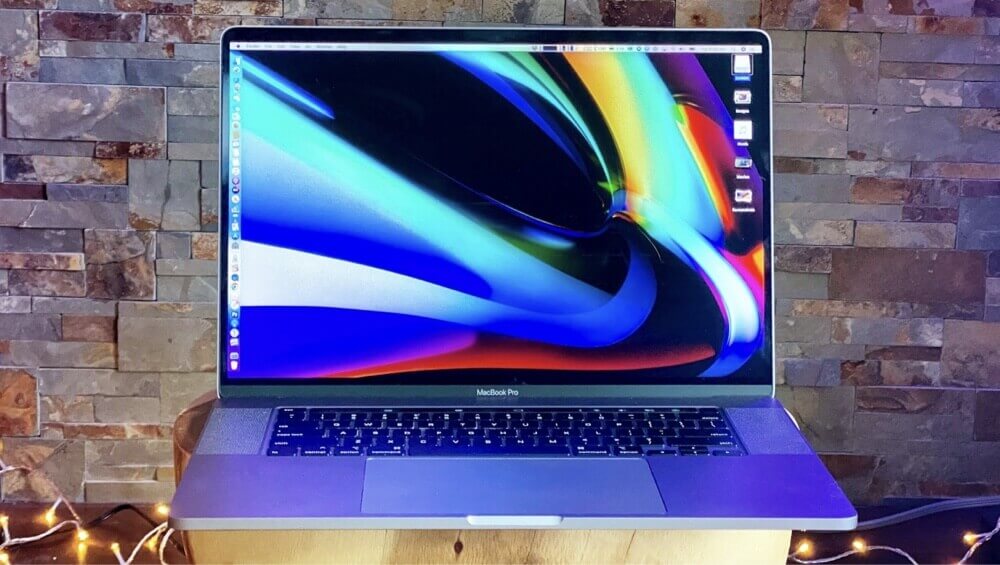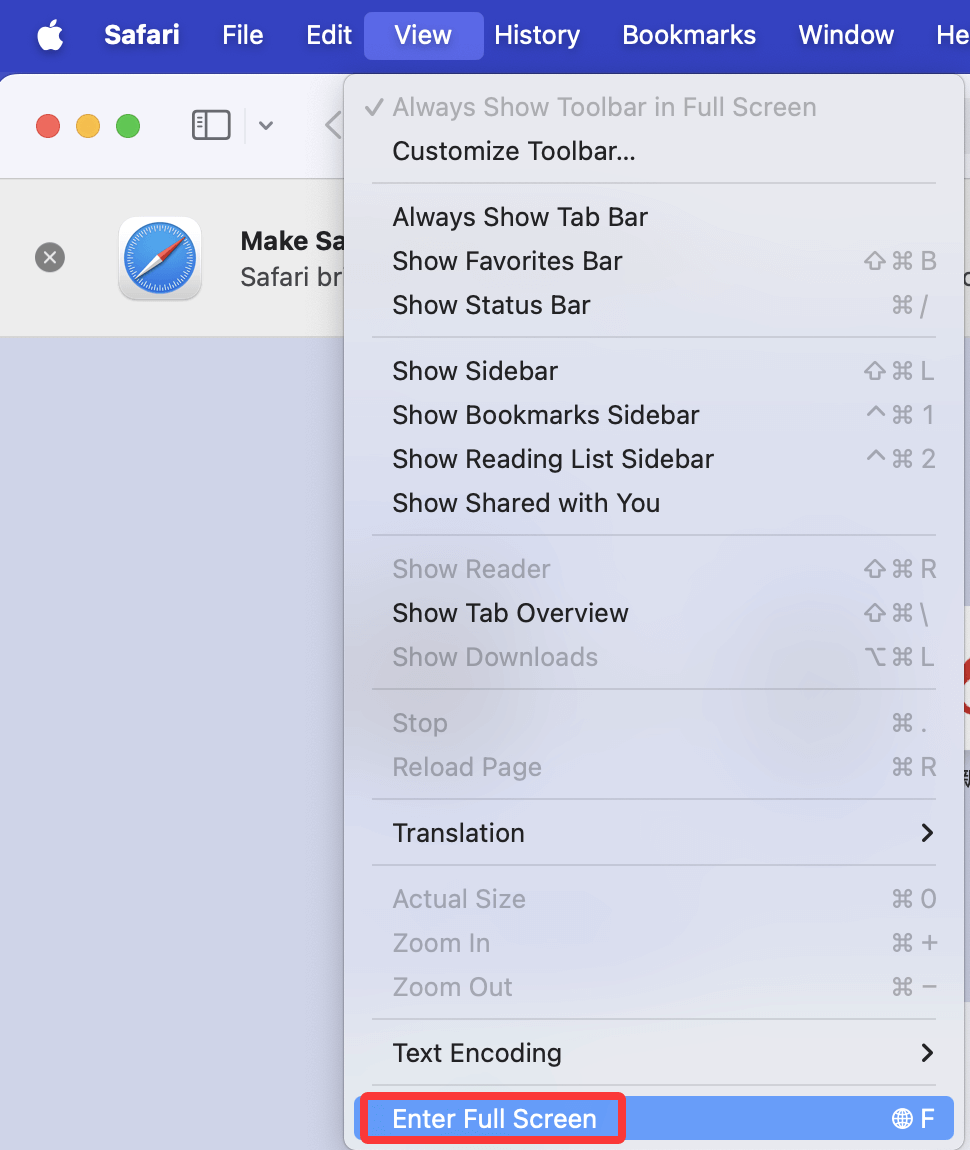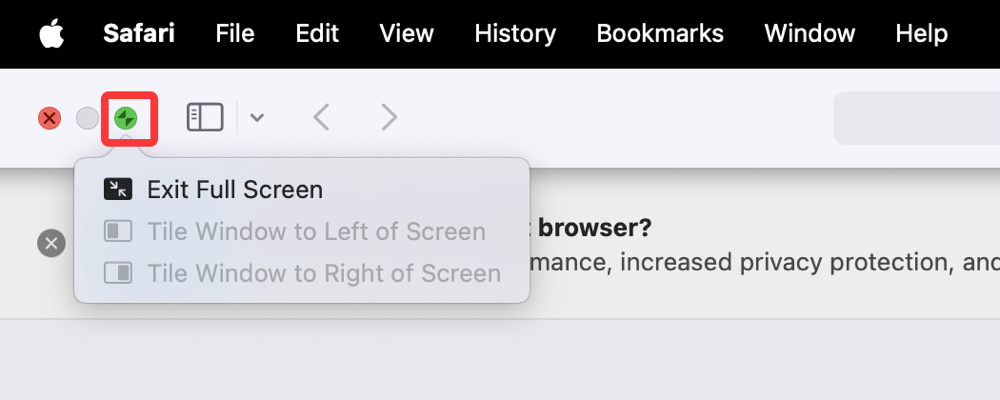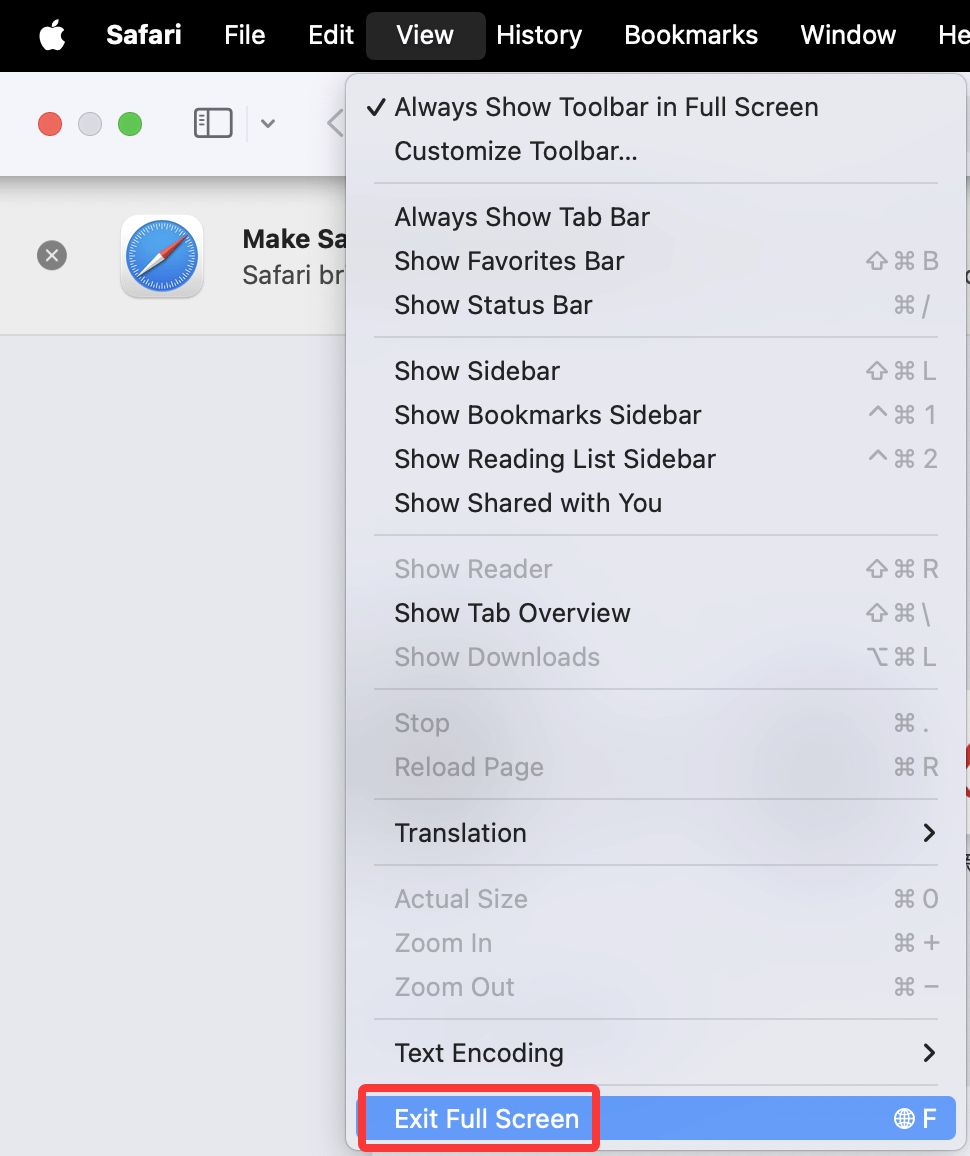PAGE CONTENT:
Mac users often praise macOS for its sleek, intuitive interface and user-friendly features. Among these features, full screen mode stands out for offering a focused and distraction-free workspace. Whether you're watching a movie, writing an essay, or organizing documents, full screen mode helps you maximize your screen real estate and enhance productivity. But how do you enter and exit full screen mode on a Mac?
In this guide, we'll cover everything you need to know about using full screen mode on macOS - from keyboard shortcuts and trackpad gestures to troubleshooting tips and comparisons with other window management tools like Split View. Whether you're a new Mac user or a seasoned one looking to streamline your workflow, this article will help you master full screen navigation.

Understanding Full Screen Mode on macOS
Before diving into how to activate full screen mode, it's important to understand what it actually does.
When you enter full screen mode on macOS:
- The app window expands to fill the entire screen.
- The Dock and the menu bar are hidden to reduce distractions.
- The app gets its own dedicated "space" or virtual desktop.
This is different from simply maximizing a window. In maximized mode (when dragging the window corners or using the zoom feature), the menu bar and Dock still remain visible. Full screen mode creates a cleaner and more immersive environment.
Which Apps Support Full Screen Mode?
Most built-in macOS apps like Safari, Pages, Notes, Calendar, Mail, and Photos support full screen mode. Many third-party apps, including Microsoft Word, Google Chrome, and Zoom, also support it. However, some older or less maintained apps might not have this functionality.
How to Enter Full Screen Mode on Mac?
macOS offers several convenient ways to enter full screen mode. You can use the mouse, keyboard shortcuts, or menu options. Here are all the methods explained in detail:
1. Using the Green Traffic Light Button
Every Mac window has three colored buttons in the top-left corner:
- Red: Closes the window
- Yellow: Minimizes the window to the Dock
- Green: Enters or exits full screen mode
Steps to enter full screen using the green button:
- Move your mouse to the top-left corner of the window.
- Hover over the green button.
![Enter and Exit Full Screen on a Mac]()
- Click it once. The window will zoom into full screen.
💡 Tip: If you hover for a second, you'll see additional options like "Tile Window to Left of Screen" (used for Split View).
2. Using the Keyboard Shortcut: Control + Command + F
This is the quickest method if you're comfortable using keyboard commands.
Steps:
- Click on the app window to activate it.
- Press Control + Command + F.
- The app immediately enters full screen mode.
This shortcut works in most modern apps that support full screen. You can use the same shortcut to exit full screen as well.
3. Using the Menu Bar
Some applications (especially older ones or those with custom UIs) might not fully support the green button method. In such cases, you can try the menu bar.
Steps:
- Click on the "View" menu in the top menu bar (only visible when the app is active).
- Select "Enter Full Screen".
![Enter and Exit Full Screen on a Mac]()
If "View" is not available, check other menus like "Window" or "Screen."
How to Exit Full Screen Mode?
Once you're done using an app in full screen, you’ll want to return to normal windowed mode. There are a few ways to do this:
1. Using the Green Button Again
Steps:
- Move your cursor to the top edge of the screen until the title bar and traffic light buttons reappear.
- Click the green button again.
![Enter and Exit Full Screen on a Mac]()
This will shrink the window back to its previous size and return you to your regular desktop space.
2. Using the Keyboard Shortcut Again: Control + Command + F
Just like entering full screen mode, this keyboard shortcut toggles it off.
Steps:
- Press Control + Command + F.
- The window exits full screen and reverts to its previous position.
This is especially useful if you're using macOS in a multi-monitor setup or switching frequently between apps.
3. Using the Menu Bar
If the menu bar is visible (when you move your cursor to the top), you can navigate out of full screen from there.
Steps:
- Move your mouse to the top of the screen.
- Click "View" > "Exit Full Screen."
![Enter and Exit Full Screen on a Mac]()
Again, the menu location might differ slightly depending on the app.
Additional Tips and Troubleshooting: Mac Full Screen
While macOS makes full screen easy, there are scenarios where things may not work as expected. Here are some tips and troubleshooting strategies:
1. Green Button Doesn't Show Full Screen Option?
If clicking the green button doesn't activate full screen:
- Hover over the button longer to see additional options.
- Try Control + Command + F instead.
- Make sure the app is updated. Older apps may lack support.
- Check if the app has its own window settings or preferences.
2. App Doesn't Support Full Screen?
Apps that use custom interfaces (e.g., some games or legacy software) might not support full screen mode in the traditional sense. In that case:
- Look for a built-in full screen toggle within the app's settings.
- Use Mission Control or a third-party window manager as an alternative.
3. Can't Find Window After Exiting Full Screen?
Sometimes, after exiting full screen, the window might appear off-screen or in a different space.
Fix:
- Use Mission Control (swipe up with three fingers or press F3) to locate all open windows.
- Use Window > Zoom or Window > Bring All to Front from the menu bar if available.
Managing Full Screen Apps with Mission Control
macOS uses "Spaces" (virtual desktops) to manage full screen apps. Every time you open an app in full screen, macOS creates a new space just for that app.
What Is Mission Control?
Mission Control is a bird's-eye view of your Mac's open windows, full screen apps, and desktop spaces. It provides a panoramic view that helps you:
- See all open windows and full screen apps at once
- Quickly switch between apps
- Create or remove additional desktops (Spaces)
- Rearrange spaces to match your workflow
It's particularly useful when you're juggling multiple apps, especially if several are running in full screen mode.
How to Access Mission Control?
There are multiple ways to activate Mission Control:
- F3 Key (Mission Control key): Found on most Mac keyboards.
- Control + Up Arrow: The universal keyboard shortcut.
- Trackpad Gesture: Swipe up with three or four fingers, depending on your trackpad settings.
- Hot Corners: You can assign a screen corner to activate Mission Control via System Settings > Desktop & Dock > Hot Corners.
- Dock or Launchpad: Open the Mission Control app manually from the Applications folder or Dock.
What You'll See in Mission Control?
Once Mission Control is open, you'll see:
- Your desktop (Desktop 1, Desktop 2, etc.) on the top row
- Full screen apps represented as horizontal thumbnails
- All open windows for the active space displayed below
You can click on any window or space to immediately switch to it.
Using Mission Control
Activate Mission Control using:
- F3 key
- Three-finger swipe up on a trackpad
- Control + Up Arrow
From here, you can:
- View all full screen apps at the top.
- Rearrange spaces by dragging them left or right.
- Switch between spaces by clicking them.
This makes multitasking with full screen apps smoother and more organized.
Full Screen Mode vs. Split View
macOS also offers Split View, allowing you to work with two apps side by side in full screen mode. Here's how they compare:
| Feature | Full Screen Mode | Split View |
|---|---|---|
| Number of apps | 1 app per screen | 2 apps side-by-side |
| Dock & Menu Bar | Hidden | Hidden |
| Good for | Focused tasks | Multitasking |
| How to activate | Green button or shortcut | Long press green button, choose tile option |
How to Use Split View:
- Hover over the green button on a window.
- Select "Tile Window to Left of Screen."
- Select the second app to share the screen.
You can then adjust the divider to resize each window.
Keyboard Shortcuts Recap
Here's a summary of essential keyboard shortcuts for managing full screen windows:
| Shortcut | Function |
|---|---|
| Control + Command + F | Enter/Exit full screen |
| Control + ↑ | Open Mission Control |
| Control + ↓ | App Exposé (view all windows of current app) |
| Control + ← / → | Switch between Spaces (including full screen apps) |
| Command + Tab | Switch between open apps |
Bonus: Trackpad Gestures for Full Screen and Spaces
macOS supports trackpad gestures that complement full screen usage:
- Three-finger swipe left/right: Navigate between Spaces (including full screen apps).
- Three-finger swipe up: Open Mission Control.
- Pinch with thumb and three fingers: Show Launchpad.
You can customize or enable gestures under System Settings > Trackpad > More Gestures.
Conclusion
Full screen mode on a Mac is a simple yet powerful feature that allows for cleaner, more focused workspaces. Whether you're editing photos, reading an article, or just decluttering your view, knowing how to enter and exit full screen mode effectively can transform your user experience.
To summarize:
- Use the green traffic light button, Control + Command + F, or the menu bar to enter or exit full screen.
- Manage full screen apps using Mission Control or gestures.
- Combine full screen with Split View for multitasking.
- Troubleshoot apps that don't support full screen and explore alternatives like window zoom or third-party managers.
Once you get the hang of it, full screen mode becomes second nature and helps you get the most out of your Mac's display.


DMcleaner for Mac
Donemax DMcleaner for Mac is an award-winning Mac cleanup & maintenance application. It offers 10+ tools to help Mac users clean up junk data on Mac, uninstall unwanted apps & delete leftovers, shred files, delete duplicate files, free up disk space, speed up slow Mac, etc. It is also a smart switch manager for Mac, a powerful disk manager for Mac.
Related Articles
- Aug 21, 202513 Fixes to Fix Can't Open a PDF Document on Mac
- Oct 18, 2024How to Empty or Force Empty Trash on Mac?
- Dec 23, 2024Fix LaCie External Hard Drive Read-Only on Mac: Comprehensive Guide
- Jul 25, 2024Fix Cannot Open Disk Utility on Mac
- Aug 10, 2025How to Enable or Disable macOS Auto-Update?
- Jan 14, 2025Reset or Change Encrypted APFS Drive's Password

Maria
Maria is one of the senior writers & editors of Donemax who lives and works in Sydney, Australia. She loves PC, Mac and Internet Technology. She has 6 years of writing articles about data recovery on PC/Mac, disk cloning solution, data eraser and computer OS optimization, etc. She is also interested in testing various software and digital products.

Gerhard Chou
In order to effectively solve the problems for our customers, every article and troubleshooting solution published on our website has been strictly tested and practiced. Our editors love researching and using computers and testing software, and are willing to help computer users with their problems




